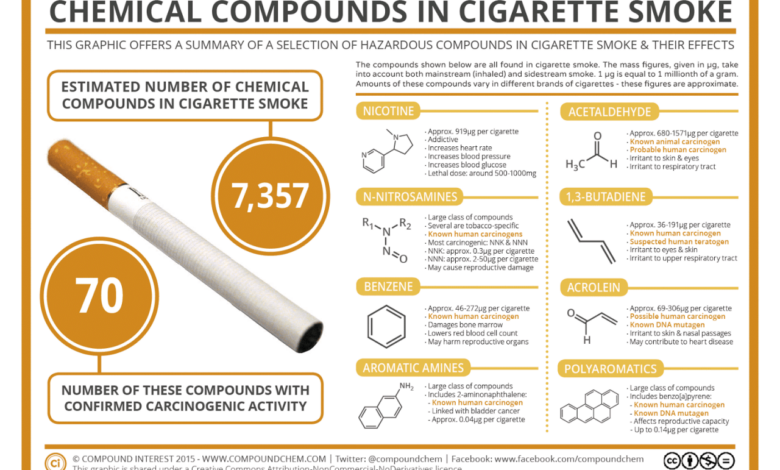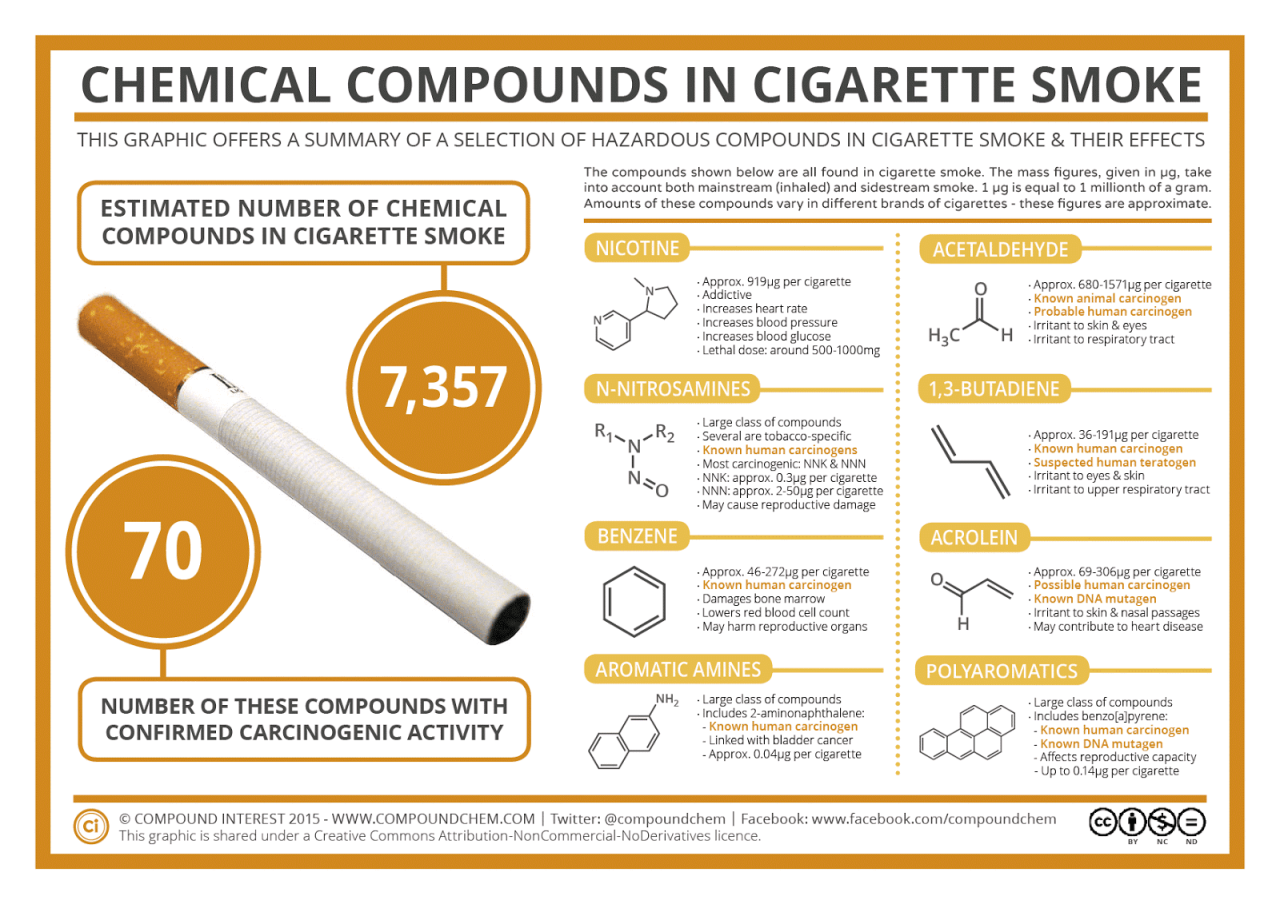
Pesticides: Potentially as Bad as Smoking for Cancer Risk
Pesticides potentially as bad as smoking for increased risk of certain cancers – this alarming statement reflects a growing body of research linking pesticide exposure to a heightened risk of developing various cancers. The evidence suggests that pesticides, commonly used in agriculture, residential settings, and even occupational environments, can disrupt cellular processes, leading to uncontrolled cell growth and ultimately, cancer.
This disturbing link raises serious concerns about the potential health consequences of pesticide use, especially given the widespread exposure to these chemicals. From the food we consume to the air we breathe, pesticides are present in our environment, and their impact on human health is a topic of ongoing scientific investigation and public health concern.
The Link Between Pesticides and Cancer
The use of pesticides in agriculture and other industries has been a common practice for decades, but recent research has raised concerns about the potential health risks associated with these chemicals. While pesticides are designed to control pests and diseases, they can also have unintended consequences for human health, particularly when it comes to an increased risk of developing certain cancers.
Types of Cancer Linked to Pesticide Exposure
Numerous studies have linked pesticide exposure to an increased risk of various types of cancer. These cancers include:
- Leukemia:Research has shown a correlation between exposure to certain pesticides, particularly organochlorines, and an increased risk of developing leukemia, a type of blood cancer. For example, a study published in the journal “Cancer Epidemiology, Biomarkers & Prevention” found that agricultural workers exposed to organochlorine pesticides had a significantly higher risk of developing leukemia compared to those who were not exposed.
- Non-Hodgkin’s Lymphoma:Exposure to pesticides, including herbicides and insecticides, has been linked to an increased risk of non-Hodgkin’s lymphoma, a type of cancer that affects the lymphatic system. A study published in the “American Journal of Epidemiology” found that farmers who used herbicides and insecticides were more likely to develop non-Hodgkin’s lymphoma than those who did not.
It’s scary to think that pesticides might be as bad as smoking for certain cancers, but it’s a reality we need to face. It’s a reminder that even when we’re trying to enjoy ourselves, like sipping a cocktail at the world’s best hotel bars, the Omnia in Zermatt, Switzerland , we should be mindful of the unseen dangers lurking in our environment.
Maybe it’s time to reconsider our relationship with pesticides and prioritize a healthier lifestyle.
- Multiple Myeloma:Studies have suggested a potential link between exposure to certain pesticides, such as glyphosate, and an increased risk of multiple myeloma, a type of cancer that affects the bone marrow. A study published in the “Journal of Occupational and Environmental Medicine” found an association between glyphosate exposure and an increased risk of multiple myeloma in agricultural workers.
- Brain Cancer:Some studies have linked exposure to pesticides, including organophosphates, to an increased risk of developing brain cancer. A study published in the “Journal of the National Cancer Institute” found that farmers who used organophosphate pesticides had a higher risk of developing brain cancer compared to farmers who did not.
- Prostate Cancer:Research has suggested a possible link between exposure to certain pesticides, such as DDT, and an increased risk of prostate cancer. A study published in the “Journal of Urology” found that men who had higher levels of DDT in their blood had a higher risk of developing prostate cancer.
Mechanisms of Pesticide-Induced Carcinogenesis
Pesticides, designed to protect crops and control pests, can inadvertently pose health risks to humans, including an increased risk of developing cancer. Understanding how these chemicals contribute to cancer development is crucial for informing public health policies and mitigating potential risks.
Disruption of Cellular Processes
Pesticides can interfere with various cellular processes, leading to uncontrolled cell growth, a hallmark of cancer.
- Hormonal Disruption:Some pesticides mimic or block the action of hormones, such as estrogen, which can disrupt normal cell growth and differentiation, potentially leading to tumor development. For instance, certain organochlorine pesticides, like DDT, have been linked to breast cancer due to their estrogenic properties.
- Immune System Suppression:Pesticides can weaken the immune system, making individuals more susceptible to infections and cancer. Some pesticides can suppress the activity of immune cells, such as lymphocytes, which are crucial for recognizing and destroying cancer cells.
- Cellular Signaling Pathways:Pesticides can interfere with signaling pathways that regulate cell growth and division. These pathways involve a complex network of proteins and enzymes that communicate within cells. Disrupting these pathways can lead to uncontrolled cell proliferation and tumor formation.
Pesticide-Induced DNA Damage
DNA damage is a key initiating event in cancer development. Pesticides can induce DNA damage through various mechanisms, leading to mutations that can contribute to uncontrolled cell growth.
- Direct DNA Interaction:Some pesticides can directly interact with DNA, causing breaks, cross-linking, or other structural alterations. This damage can interfere with DNA replication and repair, leading to mutations. For example, certain herbicides, such as glyphosate, have been shown to induce DNA damage in laboratory studies.
The news about pesticides potentially being as bad as smoking for increased risk of certain cancers is alarming, but amidst the worry, there’s always something else to catch our attention. Like the latest news at a glance, which includes a Mars rover’s trek, a collider’s restart, and a funder’s apology – all fascinating stories you can find here.
While those stories are interesting, the pesticide news is a stark reminder of the hidden dangers lurking in our everyday lives.
- Reactive Oxygen Species (ROS) Production:Pesticides can increase the production of ROS, highly reactive molecules that can damage DNA. ROS can cause oxidative stress, leading to DNA strand breaks, base modifications, and other DNA lesions. Some pesticides, such as organophosphate insecticides, are known to generate ROS.
- Epigenetic Modifications:Pesticides can alter epigenetic modifications, such as DNA methylation and histone acetylation, which regulate gene expression. These changes can influence the expression of genes involved in cell growth, differentiation, and DNA repair, contributing to cancer development.
Pesticide Exposure Pathways

Pesticide exposure is a significant public health concern, with potential implications for various health outcomes, including cancer. Understanding the pathways through which humans come into contact with pesticides is crucial for developing effective strategies to mitigate exposure risks. This section will delve into the primary routes of pesticide exposure and explore the factors that influence exposure levels.
Pesticide Exposure in Agriculture
Agricultural settings represent a major source of pesticide exposure for both workers and the general population. Pesticides are widely used in farming practices to control pests, weeds, and diseases, aiming to enhance crop yields and protect agricultural products. However, this widespread use also presents potential risks for human health.
- Direct Application:Pesticide application methods, such as spraying, dusting, and granular application, can directly expose agricultural workers to high concentrations of pesticides. The intensity of exposure depends on the specific pesticide, application method, and personal protective equipment (PPE) used.
- Drift and Runoff:Pesticides can drift off-target areas through wind or air currents, contaminating nearby water bodies, crops, and residential areas. Runoff from agricultural fields can also carry pesticides into rivers, lakes, and groundwater, posing risks to aquatic life and human health.
- Residue in Food:Pesticide residues may persist on fruits, vegetables, and other agricultural products, leading to dietary exposure. The extent of residue contamination varies depending on the pesticide, application timing, and agricultural practices.
Pesticide Exposure in Residential Settings
Pesticide use in residential settings is common for controlling pests such as insects, rodents, and weeds. While these practices may offer convenience and protection, they can also contribute to pesticide exposure.
- Indoor Pest Control:Applying pesticides indoors, such as sprays, foggers, and baits, can lead to direct exposure through inhalation, skin contact, and ingestion. The risk of exposure is heightened when proper ventilation is not ensured or when children and pets are present.
- Outdoor Pest Control:Pesticides used in lawns, gardens, and around homes can expose individuals through skin contact, inhalation, and ingestion. The risk of exposure is influenced by factors such as application method, proximity to treated areas, and personal hygiene practices.
- Contaminated Water:Pesticide residues can contaminate drinking water sources through runoff from lawns and gardens, posing a risk to human health.
Pesticide Exposure in Occupational Settings
Workers in various industries, including agriculture, forestry, pest control, and manufacturing, face a higher risk of pesticide exposure due to their occupational activities.
- Pesticide Application and Handling:Workers involved in pesticide application, mixing, and handling are directly exposed to high concentrations of pesticides, posing significant health risks. The type of pesticide, application method, and personal protective equipment (PPE) used influence the level of exposure.
- Manufacturing and Processing:Workers in pesticide manufacturing and processing facilities are exposed to pesticides during production, packaging, and transportation, increasing their risk of chronic health effects.
- Maintenance and Repair:Workers involved in maintaining and repairing equipment used in pesticide application or handling may be exposed to pesticide residues, particularly if proper safety protocols are not followed.
Comparing Pesticide Exposure to Smoking

Pesticide exposure and smoking are both significant environmental risk factors for cancer development, and understanding their individual and combined effects is crucial for public health. While both factors can lead to various types of cancer, there are notable differences in their mechanisms and the specific cancers they are associated with.
Similarities in Cancer Mechanisms
Both pesticide exposure and smoking contribute to cancer development through similar pathways, primarily by damaging DNA and interfering with cellular processes. These disruptions can lead to uncontrolled cell growth and the formation of tumors.
- DNA Damage:Pesticides and tobacco smoke contain various carcinogens that can directly damage DNA, leading to mutations that promote cancer development. For example, certain pesticides, like organochlorines, can cause DNA adducts, which are chemical modifications that can disrupt gene expression and lead to uncontrolled cell growth.
Similarly, tobacco smoke contains polycyclic aromatic hydrocarbons (PAHs), which are known to cause DNA damage and are associated with lung cancer.
- Cellular Processes:Both factors can disrupt normal cellular processes, such as cell cycle regulation, apoptosis (programmed cell death), and DNA repair. Pesticides can interfere with the activity of enzymes involved in these processes, while tobacco smoke contains reactive oxygen species (ROS) that can damage cellular components and impair DNA repair mechanisms.
Differences in Cancer Risks, Pesticides potentially as bad as smoking for increased risk of certain cancers
While both pesticide exposure and smoking are associated with an increased risk of cancer, the specific types of cancer and the magnitude of risk vary.
The news about pesticides potentially being as bad as smoking for increased risk of certain cancers is alarming, especially when you consider the global impact of environmental toxins. It’s a reminder that health issues often stem from a complex web of factors, just like how tuberculosis is the oldest pandemic and poverty makes it continue.
While we focus on the immediate threat of pesticides, we must also consider the long-term consequences of environmental degradation on human health and the need for sustainable solutions.
- Pesticides:Exposure to certain pesticides, particularly organochlorines, has been linked to an increased risk of various cancers, including non-Hodgkin lymphoma, leukemia, multiple myeloma, and prostate cancer.
- Smoking:Smoking is a major risk factor for lung cancer, but it is also associated with a higher risk of other cancers, including cancers of the bladder, cervix, esophagus, kidney, larynx, mouth, pancreas, stomach, and liver.
Synergistic Effects
There is growing evidence suggesting that the combined effects of pesticide exposure and smoking may be synergistic, meaning that the risk of cancer development may be greater than the sum of the individual risks. This could be due to the fact that both factors damage DNA and disrupt cellular processes, potentially amplifying the effects of each other.
For instance, studies have shown that smokers exposed to certain pesticides, such as organochlorines, have a significantly higher risk of developing lung cancer compared to non-smokers exposed to the same pesticides.
Public Health Implications: Pesticides Potentially As Bad As Smoking For Increased Risk Of Certain Cancers
The established link between pesticide exposure and increased cancer risk presents a significant public health concern. Understanding the mechanisms by which pesticides contribute to carcinogenesis, the pathways of exposure, and the potential magnitude of risk compared to other known carcinogens like smoking, is crucial for implementing effective public health strategies.
Strategies for Reducing Pesticide Exposure
Minimizing pesticide exposure is a critical step in mitigating the associated health risks. This can be achieved through a multi-pronged approach involving individuals, communities, and regulatory bodies.
- Promoting Organic Farming and Consumption:Encouraging the adoption of organic farming practices, which minimize or eliminate pesticide use, can significantly reduce exposure. Consumers can actively choose organic produce, contributing to a demand for pesticide-free food production.
- Implementing Integrated Pest Management (IPM):IPM strategies emphasize using a combination of biological, cultural, and chemical controls to manage pests. This approach aims to reduce reliance on synthetic pesticides while maintaining crop yields and minimizing environmental impact.
- Regulating Pesticide Use and Application:Stricter regulations on pesticide use, including limitations on specific chemicals, application methods, and buffer zones around sensitive areas, can help reduce exposure.
- Public Education and Awareness Campaigns:Educating the public about the potential risks of pesticide exposure, safe handling practices, and alternatives to chemical pest control is essential. Raising awareness about the link between pesticide exposure and cancer can empower individuals to make informed choices.
- Protecting Vulnerable Populations:Special attention should be given to protecting vulnerable populations, such as children, pregnant women, and individuals with pre-existing health conditions, from pesticide exposure.
Importance of Awareness and Education
Public awareness and education are crucial for reducing pesticide exposure and mitigating the associated health risks. Understanding the potential dangers of pesticide use empowers individuals to make informed choices about their health and the environment. This includes:
- Choosing Pesticide-Free Products:Consumers can actively choose pesticide-free produce, household products, and gardening supplies.
- Practicing Safe Handling:Properly handling pesticides, wearing protective gear, and following label instructions can minimize exposure during application.
- Supporting Sustainable Agriculture:Individuals can support sustainable farming practices, such as organic farming, which prioritize environmental health and reduce pesticide use.
- Advocating for Policy Changes:Educated citizens can advocate for stricter regulations on pesticide use and support policies that prioritize public health and environmental protection.
Final Wrap-Up

The growing evidence linking pesticide exposure to cancer risk underscores the importance of adopting preventive measures to minimize our exposure to these potentially carcinogenic chemicals. This includes supporting sustainable farming practices that reduce pesticide use, opting for organic produce whenever possible, and being mindful of pesticide use in our homes and gardens.
By taking proactive steps to reduce our exposure, we can help safeguard our health and contribute to a healthier future for ourselves and future generations.






